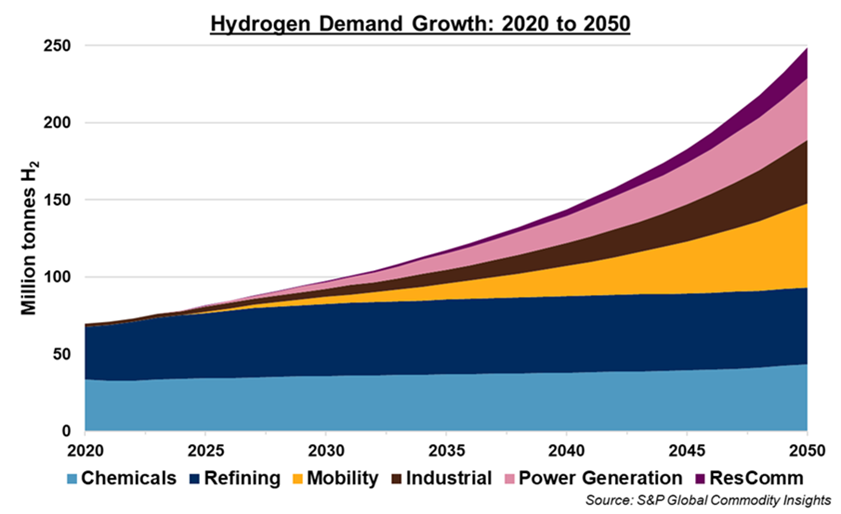Global Energy Leaders Join Open Hydrogen Initiative (OHI) to Unlock Hydrogen’s Full Potential
GTI Energy and S&P Global Commodity Insights convene diverse field of experts to objectively measure carbon intensity of hydrogen production at asset level and advance hydrogen market transparency
December 13, 2022
Des Plaines, IL
GTI Energy and S&P Global Commodity Insights today announced a cohort of new stakeholders to their Open Hydrogen Initiative (OHI), a recently announced collaboration to further transparency into the environmental impact of hydrogen production and help unlock its full potential as a fuel alternative and important driver of energy transition. The mission is to create an industry-led objective, credible, and harmonized methodology and toolkit for measuring the carbon intensity of hydrogen production at the facility level to lay the foundation for a low-carbon hydrogen marketplace.
“The new Open Hydrogen Initiative participants announced today will provide crucial marketplace insight to vet the technical protocols and methodologies the initiative will ultimately develop for industry, policymakers, and investors,” said Paula Gant, Ph.D., President and CEO of GTI Energy. “Each founder and stakeholder brings various levels of technical support, R&D perspective, and real-world marketplace insights to close the methodology gap that undermines the commoditization of hydrogen.”
Initial OHI industry stakeholders now include EQT, National Grid, Shell, ExxonMobil, Dominion Energy, LanzaTech, Equinor, BlackHills Corporation, Nicor Gas, NYSEG, Oklahoma Natural Gas, Duke Energy, DTE, and Southwest Gas Corporation. Nonprofit, academic, and observer partners include Clean Air Task Force, The University of Newcastle Australia, Queen Mary University of London, Columbia University, Stanford University’s Hydrogen Initiative, Breakthrough Energy, Bipartisan Policy Center, Center for Houston’s Future, Government of Alberta, Clean Hydrogen Future Coalition, Renewable Hydrogen Alliance, Operations Technology Development (OTD), Evergreen Climate Innovations, and Hydrogen Forward.
Development of the OHI measurement toolkit is already underway and ongoing, with a launch of demonstration projects targeted within the next 16 months. Initial stakeholder work is centered on the characterization of hydrogen production processes to understand energy and material flows and major emissions hotspots.
The Open Hydrogen Initiative is focused on identifying real-world applicability and credible carbon intensity values for a range of production methods, all critical to ensure a sustainable growth trajectory of hydrogen in the marketplace. Government programs to support the growth of a low-carbon hydrogen market are being implemented around the world.
"The Inflation Reduction Act in the US is just one example of regulators and market participants putting life-cycle carbon emissions at the center of strategies to support the growth of the hydrogen market. Peer-reviewed and transparent open-sourced measurement tools and methodologies are necessary to determine the carbon footprint of hydrogen entering the market. The European Union's creation of the Hydrogen Bank, which will invest Euro 3 billion in low-carbon hydrogen projects, is another example of measures aimed at supporting the scaling of low-carbon hydrogen markets," said Alan Hayes, Head of Energy Transition Pricing and Market Data at S&P Global Commodity Insights.
Subsequent to the COP27 inter-governmental discussions, it is clear that hydrogen remains one of the key routes available to advance projects worldwide that can contribute to decarbonisation.
Precision Necessary for Low-Carbon Transparency
OHI-developed tools will be critical to move beyond the current color spectrum labeling method of carbon intensity measuring, which only represents the method by which energy is produced. Two molecules of “blue” hydrogen, or hydrogen produced by natural gas with carbon capture, can have highly variable carbon footprints depending on the facilities in which they were produced. OHI founders believe an equitable comparison of carbon intensity at the facility level of hydrogen production could be a game changer, allowing for more precise, granular measurements, such as kilograms of carbon dioxide produced per kilogram of hydrogen.
According to S&P Global Commodity Insights’ hydrogen outlook, global hydrogen demand grows from 70.4 million tons in 2020 to 97 million tons in 2030 and 249 million tons in 2050. Hydrogen demand is currently concentrated in oil refining and ammonia production, but nearly 90% of projected demand growth through 2050 comes from new sectors like heavy-duty transportation, steel production, and long-term energy storage. Decarbonizing hydrogen supply is critical to initiate uptake in these new sectors, and an industry-standard emissions measurement and verification process is key to providing the market transparency that facilitates new supply agreements.

To lend your expertise or learn more about this the initiative, visit gti.energy/OHI or contact OHI@gti.energy.
See Sampling of OHI Stakeholder Commentary:
Alberta Energy said: “Alberta Energy applauds the efforts of the Open Hydrogen Initiative. Alberta’s Hydrogen Roadmap has committed to collaborate with other governments and international partners to support the development of science-based carbon intensity thresholds for hydrogen production. This collaboration will be important to establish carbon intensity threshold targets, definitions, and measurement and reporting standards. We look forward to working with OHI and its partners to develop a transparent and credible framework to measure the carbon intensity of hydrogen."
Meron Tesfaye, Senior Policy Analyst, Bipartisan Policy Center said: “The Bipartisan Policy Center (BPC) is pleased to serve as an observer and applauds GTI Energy and S&P Global in spearheading this important initiative. Clean hydrogen has the potential to play an important role in the energy transition and this effort will help ensure that its climate benefits are well understood."
Brett Perlman, CEO, Center for Houston’s Future said: “Center for Houston’s Future (CHF) is excited to be part of this initiative and to bring our perspective from Houston, a global leader in developing and growing energy markets and the home of significant hydrogen commerce. We have consistently said that a key to scaling the clean hydrogen market is moving beyond the ‘color spectrum’ in favor of a rigorous, transparent standard that reflects well-to-gate carbon intensity. CHF is also coordinating with and organizing other emerging clean hydrogen hubs domestically and globally to ensure a vibrant, cross-region clean hydrogen market. We are pleased to work with other OHI stakeholders and observers on a common vision.”
Magnolia Tovar, Zero-Carbon Fuels Global Director, Clean Air Task Force said: “We need a combination of harmonized standards, regulations and market mechanisms that reward the cleanest hydrogen production and create confidence for market development. OHI will build industry access to necessary tools for rigorous monitoring and verification of emissions associated with all production pathways.”
Chris Golden, SVP and U.S. Country Manager, Equinor said: “Hydrogen will be a key contributor to the energy transition. Continuing our decades of innovation, we are proud to participate in projects like OHI to show how hydrogen can provide scalable and profitable growth opportunities in the future."
Toby Rice, President and CEO, EQT said: “As the nation’s largest natural gas producer, EQT is dedicated to exploring gas-based climate solutions such as hydrogen. We believe OHI is on the forefront of establishing a credible industry framework for measuring the carbon intensity of hydrogen, which is a market must-have for an energy sector transitioning to low-carbon fuels and technologies in the coming years."
Ross Turrini, COO, National Grid New York said: “At National Grid, we see significant potential to deliver low carbon energy including blending of green hydrogen and renewable natural gas using our existing underground assets. OHI’s commitment to measure carbon intensity with greater transparency will enable clean hydrogen to be available for the clean energy future.”
About GTI Energy
GTI Energy is a technology development and training organization. Our trusted team works to scale impactful solutions that shape energy transitions by leveraging gases, liquids, infrastructure, and efficiency. We embrace systems thinking, innovation, and collaboration to develop, scale, and deploy the technologies needed for low-emission, low-cost, and resilient energy systems.
About S&P Global Commodity Insights
At S&P Global Commodity Insights, our complete view of global energy and commodities markets enables our customers to make decisions with conviction and create long-term, sustainable value. We’re a trusted connector that brings together thought leaders, market participants, governments, and regulators and we create solutions that lead to progress. Vital to navigating commodity markets, our coverage includes oil and gas, power, chemicals, metals, agriculture, shipping and energy transition. Platts® products and services, including the most significant benchmark price assessments in the physical commodity markets, are offered through S&P Global Commodity Insights.
Share This News
We welcome you to share via your social media or email







